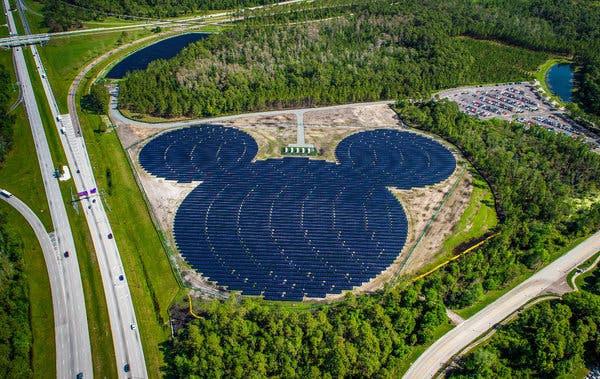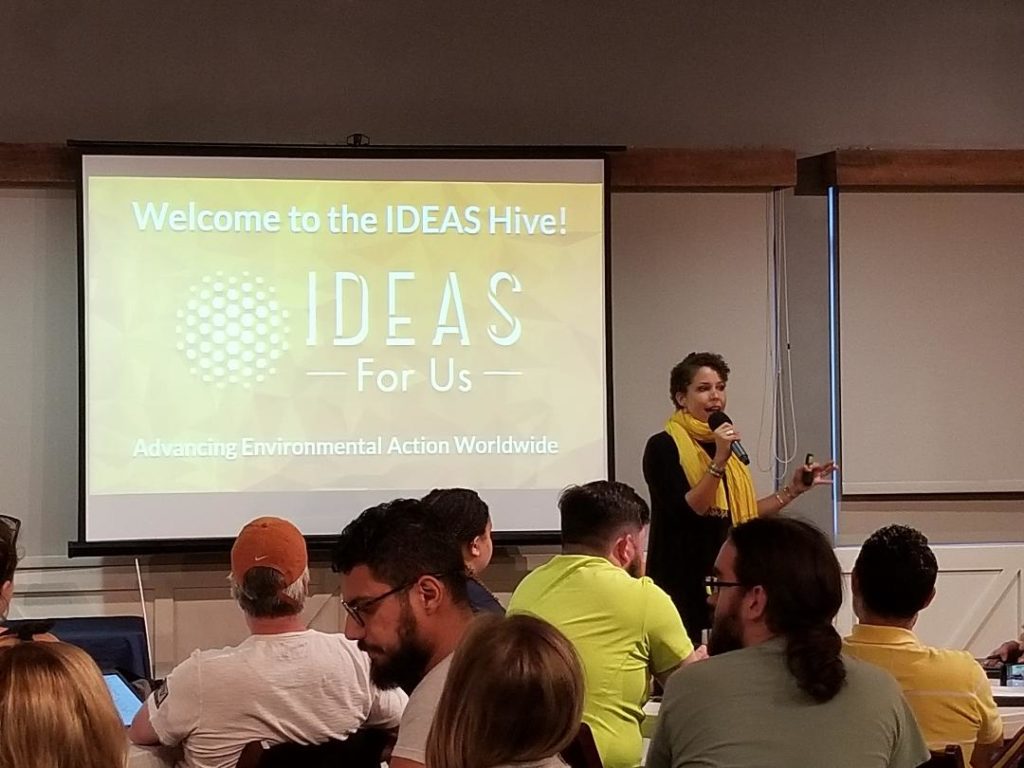Known for its enchanting beaches, secluded springs and year-round sunshine, Florida brims with natural resources. And lately, it’s made great strides in using those resources for good. Consider what the state has accomplished this year alone.
In January, Florida Power and Light Co., the state’s largest electric provider, made an announcement. They plan to install more than 30 million solar panels by 2030. According to FPL, if it meets this installation goal within the given time frame, it could increase solar energy use by 20 percent and decrease carbon dioxide emissions (the greatest cause of air pollution) 67 percent.
Its mission: to make Florida a “world leader in the production of solar energy,” the Juno Beach-based utility says.
But FPL isn’t the only one jostling for that title. Florida’s theme park giant Disney World has made some of the nation’s largest contractual commitments in the solar sector. Earlier this year the second of its two massive solar farms went online. It’s a 270-acre, 50-megawatt solar facility. They expect it to generate enough power from the sun to operate two of its four theme parks. Its first solar plant—smaller by comparison but notably more charming, with its 22-acre Mickey Mouse-shaped design—was unveiled in 2016.
According to Disney’s estimates, the new site, featuring 500,000 solar panels, will reduce greenhouse gas emissions by more than 57,000 tons per year, the equivalent to “removing about 10,000 cars from the road,” Angie Renner, Environmental Integration Director of Disney Parks, told Good Morning America, in April.

Photo credit: The New York Times
Still, even with Florida’s efforts toward eliminating its carbon footprint, the question remains: What portion of these climate actions, executed by utilities and major corporations, directly benefit consumers?
On the one hand, there’s the obvious public health advantage. Fewer carbon emissions mean less air and water pollution, less contaminated drinking water and inhaled airborne toxins. On the other hand, utilities continue to deploy wide-ranging renewable energy contracts. While, lawmakers have little incentive to extend solar jobs to third parties or residents. As it stands, local utilities hold unmitigated control over Florida’s electric marketplace. This means they monopolize not only large-scale solar plants, like at Disney, but also smaller residential installations.
If a homeowner wants to install rooftop panels, for instance, he cannot go through a third-party company or undertake the task himself. Instead they must negotiate with the utility provider in his service area.
The energy bill, House Bill 97/Senate Bill 256, in effect, hopes to change that. Filed by state Rep. Anna V. Eskamani and Sen. Jose Javier Rodriguez, the bill calls for a statewide commitment to be 40 percent renewable by 2030, and 100 percent by 2050. To the extent that it conveys a direct objective, it’s to motivate Florida sectors toward a “unified plan.” Unlike many bills of its kind—replete with arcane language and idealistic goals—this energy bill, in all, is two and a half pages, making clear its aim, but without an explicit strategy for how to get there.
And that ambiguity is the point, says Jeff Benavides, chief sustainability officer with L.E. Rigby Innovations, an organization that provides human backup power to help global companies complete projects and achieve sustainability goals. “The bill is unprecedently short,” he explains, “because it’s really just a commitment to do better by our state.”
Some environmental groups might contend that having just a goal is not enough. There should also be a plan of action in place. Getting all parties involved to agree on a focused target is at least a start, Benavides says. “Given our history here in the state and how things have consistently gotten shut down, and how we’ve literally had no progress at the state Legislature level, this bill is a step in the right direction.”
Working toward a grid that operates on 100 percent renewable energy, however, requires an overhaul in how Florida provides electricity to consumers. With its dense populations, especially in urban cities such as Miami and Orlando, Florida ranks as one of the largest electricity-producing states in the nation. Florida is second only to Texas.
Although the state uses a combination of fossil fuels—coal, petroleum, nuclear—natural gas generates more than two-thirds of Florida’s electricity, according to a 2017 report by the Energy Information Administration. This is especially disconcerting given that Florida’s electricity demand outstrips supply. This causes more extractive energy companies to rely on fossil fuels. Electricity, researchers have found, is the second-highest source of greenhouse gas emissions, next to transportation.
If Florida hopes to accomplish its renewable energy goals in the next few decades, residents, businesses and utilities will have to find cleaner alternatives to natural gas. While solar has recently become a popular choice, due to its decreasing costs and tax credits, it still accounted for only 1 percent of Florida’s electricity generation last year.

Photo Credit: Environmental Protection Agency
Renewable energy—energy harvested and produced by natural resources, such as sunlight, wind, and water—is not only a sustainable energy source but a viable solution to eliminating water and air pollution.
To be sure, converting to 100 percent renewable energy is an investment—some solar installations, for instance, can run $20,000 or more—but the cost of keeping the status quo has far greater consequences: more annual deaths (particularly from heat strokes and respiratory-related conditions) and climate change disasters (floods, hurricanes, droughts).
According to the World Health Organization, “climate change is expected to cause approximately 250,000 additional deaths per year,” between 2030 and 2050. One Harvard study even found that the public health effects of nonrenewable energy can cost the U.S. an estimated $74.6 billion per year.
Just as climate change affects everyone, so does cultivate a movement toward reversing its effects. More than stabilizing the planet’s warming temperatures, climate action permeates all aspects of society, spurring communities of support, equitable access to natural resources and opportunities for activists to have a voice—regardless of age, race, gender and socioeconomic status.
HB97/SB256, inspired by Greta Thunberg’s youth climate strikes, lays the groundwork for such changes to take place, without getting mired in specifics—well-meaning goals that might be impossible to achieve. Given that Florida has never had a renewable energy portfolio, or “any efficiency goals, for that matter,” Benavides says, “this bill gets us at least, on a legislative level, a call to action.” Additionally, it gives energy advocates, lawmakers and utilities “something to refer back to,” he says. “We can utilize this bill as leverage to set a precedent for the Public Service Commission,” which mandates restrictions on utility companies.
One potential outcome of the energy bill is that it could deregulate the electric marketplace, prompting a customer-centered model that allows residents to choose their own solar installation provider. Although Florida’s residents and commercial businesses have favorable tax exemptions on solar, thanks to Amendment 4, which passed in 2017, it is still illegal for third parties to sell electricity to customers. Recent ballots, like the one proposed by the residential installer Sunrun last year, allow third parties to lease equipment to customers, but only regulated utilities can provide installation, keeping the majority of profits for themselves and competition at bay.
The solar battle has a long, thorny history in Florida, with amendments quashed on both sides of the energy-war spectrum—from politicians who capitalize on power companies’ hefty campaign contributions, ensuring that utilities maintain control of the energy sector; to environmentalists who want a state that’s 100 percent renewable, or at least working in that direction. As Benavides puts it, remaining in a political stalemate is, unfortunately “the position we find ourselves in”—until we can convince Legislature, and the Public Service Commission, to wrest control from utilities.
Another positive outcome of the energy bill, HB97/SB256, which would directly result from an open electric marketplace, is that it could pave the way for more sustainability jobs. But here’s the catch: Though the energy sector needs qualified candidates who can enter a specialized workforce, utilities have laid claim to the market, preventing outsiders from filling high-in-demand positions.

Photo: Trina Ryan
This was the topic of October’s Hive meeting with IDEAS For Us. Hive meetings, in part, educate the public on how to develop their ideas on sustainability into effective action. Benavides and his wife, Michelle Benavides, were guest speakers at the event.
Their message was to raise awareness that the renewables industry is rapidly expanding—300 multinational businesses are driving climate action on renewable power, used in more than 140 markets worldwide, according to The Climate Group’s statistics. They also noted that 470 million jobs are needed globally to achieve sustainable development goals by 2030. Still, even with the immense growth, they explained, eager candidates are having difficulty finding work, and the workforce is having difficulty finding qualified candidates.
Instead of hiring local third parties, utilities recruit workers elsewhere, often outside the state, “and they’ve gotten really comfortable and efficient with doing that,” Benavides says. “They’re not providing sustainable, permanent jobs for Floridians. They’re negotiating these contracts on a national level, and it’s just trickling down.”
While the utility industry’s dominance over the electric marketplace is well documented, HB97/SB256 energy bill presents a unique stance on the renewable energy movement: paring down the goal to its most basic components—a target of 40 percent renewable energy by 2030 and 100 percent by 2050—it obviates the need for partisanship or political hand-wringing. “The bill sets a target so that Legislature can push the utilities to meet that target and uphold their commitments,” Benavides says. “That’s the key. How we get there is up for debate, but at least we’ll be unified in why we’re getting there.”

Resources:
To sign the petition for the energy bill, HB97/SB256, visit https://www.change.org/p/joseph-abruzzo-demand-state-renewable-energy-goals-for-florida-support-hb97-sb256?use_react=false&expired_session=true
To learn more about how solar power works see our blog at https://ideasforus.org/solar-powered/.
To find out more about L.E. Rigby Innovations, visit https://www.lerigby.com/.
See if going solar is an option for you. Visit https://www.nrdc.org/stories/should-you-go-solar.
Sources:
https://www.sierraclub.org/ready-for-100
https://www.sun-sentinel.com/business/fl-bz-fpl-solar-panel-installation-20190116-story.html
https://www.orlandosentinel.com/business/os-disney-duke-solar-20160412-story.html
https://www.orlandosentinel.com/business/os-bz-disney-solar-farm-20190418-story.html
https://www.miamiherald.com/news/politics-government/article17474102.html
https://www.nytimes.com/2019/07/07/business/energy-environment/florida-solar-power.html
https://www.census.gov/newsroom/press-releases/2018/estimates-national-state.html
https://www.eia.gov/state/?sid=FL
https://www.eia.gov/state/analysis.php?sid=FL
https://www.epa.gov/ghgemissions/overview-greenhouse-gases
https://www.businessinsider.com/solar-power-cost-decrease-2018-5
https://www.eia.gov/state/analysis.php?sid=FL
https://www.nrdc.org/stories/renewable-energy-clean-facts
https://www.nrdc.org/sites/default/files/climatehealthfacts.pdf
https://www.ucsusa.org/global-warming/science-and-impacts/impacts/hurricanes-and-climate-change.html
https://www.nrdc.org/stories/global-climate-change-what-you-need-know
https://cleanenergy.org/blog/candidates-rick-scott/








